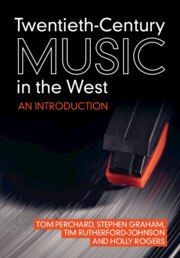Book contents
- Twentieth-Century Music in the West
- Twentieth-Century Music in the West
- Copyright page
- Contents
- Figures
- Tables
- Acknowledgements
- Introduction
- Part I Histories
- Part II Techniques and Technologies
- 5 Work and Notation
- 6 Rhythm and Time
- 7 Harmony
- 8 Instruments
- Part III Mediation
- Part IV Identities
- Bibliography
- Index
6 - Rhythm and Time
from Part II - Techniques and Technologies
Published online by Cambridge University Press: 15 September 2022
- Twentieth-Century Music in the West
- Twentieth-Century Music in the West
- Copyright page
- Contents
- Figures
- Tables
- Acknowledgements
- Introduction
- Part I Histories
- Part II Techniques and Technologies
- 5 Work and Notation
- 6 Rhythm and Time
- 7 Harmony
- 8 Instruments
- Part III Mediation
- Part IV Identities
- Bibliography
- Index
Summary
In the twentieth century as in our own time, ‘rhythm’ meant different things in different contexts. Popularly, it often suggested a type of beat or musical feel, usually something lively or active. To music specialists, it could also refer to any one of the aspects of the relationship between sound and time: attack, metre or phrase structure (or ‘period’). As the century progressed, and the new discipline of ethnomusicology began to suggest ways of understanding local music cultures as local participants did, it became apparent that many peoples had other ways of perceiving and describing what Westerners described as rhythm (Agawu 1995). In what follows, we will address changing ‘cultural’ and musicological understandings of rhythm across the century. Yet our attention will often be on the ways that musicians developed rhythmic approaches to particular aesthetic and technical ends; in these discussions we will follow the definition of Anne Danielsen (2010a: 4) and take rhythm to refer to ‘an interaction between non-sounding reference structures’, such as metre, ‘and sounding rhythmic events’, such as an attack or beat.
- Type
- Chapter
- Information
- Twentieth-Century Music in the WestAn Introduction, pp. 154 - 178Publisher: Cambridge University PressPrint publication year: 2022

